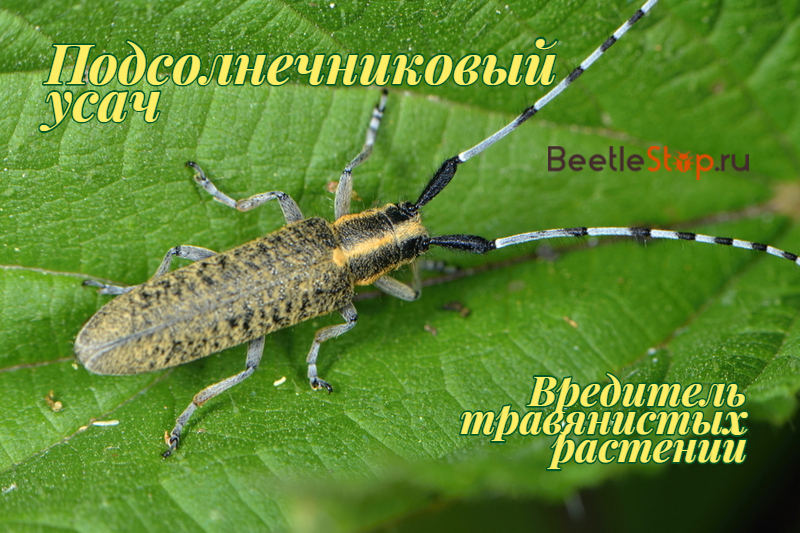Sunflower barbel - how to deal with field pest
In Russia, sunflower is the leader in growing areas among oilseeds. It is a feed plant for a large group of insects. Among the specialized types of pests, a sunflower barbel is distinguished. Insect larvae develop inside the stem, gnawing passages towards the root. Their livelihoods can lead to a sunflower fracture. Against the pest, agrotechnical and chemical methods of control are used.

View description
Among beetles of the family of barbel and lumberjacks there are many species that damage wood. But coleopterans represent a danger not only for forest plantations. Genus Agapanthsia stem barbel grow their offspring inside herbaceous plants. This group includes 64 species of insects. The beetles are united by the characteristic features of the structure: an elongated body, hair, the absence of a tuber on the pronotum. A typical representative of the genus is the sunflower barbel (Agapanthiadahlia). The length of the adult is 10-22 mm, the black body of the beetle is covered with short yellow hairs.
Information. The antennae of the male exceed the length of the body by 1.5 times, the females by 1.25 times.
The first two segments of the whiskers are completely black, the remaining 10 are yellowish or reddish at the base with a dark top. The antennae surface is covered with sparse dark hairs. Scutellum transversal, densely punctured. A wide strip of yellow hairs runs in the middle of the head and pronotum. Elytra taper to apex. On the underside of the abdomen there is a thick yellow pubescence. Transparent wings are well developed, insects make small flights.
Habitat
Insects prefer the steppe and forest-steppe zone. The species Agapanthiadahlia lives throughout Europe, the Caucasus, Kazakhstan and Asia Minor. Pests are widespread in Russia, with the exception of regions of the far north.
Lifestyle & Reproduction
The beetle years are observed from May to July. Adults are active in the daytime. After fertilization, the female gnaws a hole in the sunflower stalk at a height of 30-60 mm. The diameter of the plot for masonry is 5-8 mm. In each hole, the female lays one egg. The total fertility is 50 pieces. Eggs are cylindrical in shape with rounded ends; the color is white.
Information. In the meadow zone, where there are no crops of Pancake week crops, beetles develop on weeds: thistle, thistle, ferula, and cow parsnip.
The development of an embryo depending on air temperature takes 3–9 days. Hatching larvae begin to feed. They gnaw soft tissue inside the stem. The core is destroyed due to the moves made. The larva is narrow, long, the body is yellowish-white in color. She is deprived of legs, moves with the help of special corns on the back and abdomen.
The offspring exceeds the size of adult beetles, growing to 27-35 mm. The head of the larva is dark brown. Powerful jaws forward. The body of the larva is often bent in an arcuate shape. For wintering, the larvae descend into the underground part of the plant. They hide in the roots, closing the completed course with a cork. For shelter from the cold, a cradle is prepared from plant debris.
Usually, one generation of sunflower barbel develops per year, but under adverse conditions the larva hibernates twice. Pupation occurs in spring.This stage lasts 3 weeks. Dolly of gray color. Young beetles, which appeared in May, for the first time rest on the herbs of the Asteraceae family, then fly to the sunflower fields.
Malware
Damaged crops wither, lag behind in growth, the percentage of oil in seeds decreases. Weakened plants are defenseless against disease. With severe damage to the core, the stem breaks, the basket does not ripen.
Methods of struggle
Harm to the sunflower is caused by the offspring of barbel, the worst of all is crops of late sowing. A set of measures has been developed to combat the pest.
Agrotechnical methods:
- The use of varieties of early sowing.
- Low cutting of stems immediately after harvesting and removal from the field. Plant residues can be used as fuel or for technical purposes.
- Timely weed control.
- Deep autumnal plowing.
Chemicals
Getting to the larvae hiding in the stems of culture is quite difficult. Exposure to chemicals is aimed at adults during the summer and laying eggs. The treatment is carried out with synthetic pyrethroids of contact-intestinal action: Fastak, Mospilan.
Systemic insecticides are used that quickly destroy beetles. The most effective are Aktara, Proteus. With a slight infection of the field, you can do with the processing of the extreme rows.

